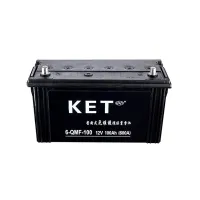With the continuous development of the green solar industry, off-grid solar power generation systems are becoming more and more popular, and battery storage plays an important role in the entire off-grid solar system. Solar lithium-ion batteries and solar lead-acid batteries are the most common battery options.
Let me introduce to you the difference between lithium-ion and lead-acid batteries, and how to choose batteries for solar systems.
Lifetime, cost and efficiency:
The service life varies. The service life of solar lead-acid batteries is generally about 2 years; solar lithium-ion batteries have strong durability and generally have a service life of 4-5 years.
Solar lead-acid batteries are a tried-and-true technology that costs less, but requires regular maintenance and doesn't last long. Solar lithium-ion batteries are a superior battery technology with longer life and higher efficiency, but you'll pay more for improved performance. Typically, solar lithium-ion batteries are at least 95% efficient, while solar lead-acid batteries are about 80-85% efficient
This is the main difference between lithium-ion batteries and lead-acid batteries.
safety:
High-current discharge of solar lead-acid batteries is not easy to occur because it has high sealing properties. Even if an accident occurs (such as leakage), the positive and negative electrodes and lead-acid electrolyte are not flammable. The electrolyte of solar lithium-ion batteries is an ester solution, which is flammable and volatile.

Different electrical characteristics: Solar lead-acid batteries cannot discharge at large currents, while solar lithium-ion batteries can discharge at large currents.
Different energy densities:
Solar lead-acid batteries are 30WH/KG, and solar lithium-ion batteries are 110WH/KG; so for power batteries with the same rated power, solar lead-acid batteries will be heavier and larger than solar lithium-ion batteries.
Generally, solar lead-acid battery packs weigh 16-30kg and are relatively large; solar lithium-ion batteries are generally 2.5-3kg and are relatively small.
Cycle life:
The cycle life of solar lead-acid batteries is about 8,000-10,000 times, and the cycle life of Lifepo4 batteries can reach 3,000 times. Solar lithium-ion batteries last longer than solar lead-acid batteries.
The number of charge and discharge cycles is different. Solar lead-acid batteries are generally fully charged and discharged within 400 times and have memory; solar lithium-ion batteries can be charged and discharged 500 times and have no memory.
battery capacity:
Battery capacities vary. The capacity of solar lead-acid batteries is about 20A; the capacity of solar lithium-ion batteries is 8-10A.
Environmental protection:
Solar lead-acid batteries cause pollution during the production process and may also cause pollution if not properly recycled; solar lithium-ion batteries are relatively green.
After understanding the differences between lithium-ion and lead-acid batteries, we can choose a more appropriate battery configuration for our off-grid solar system.
Therefore, the type of battery used in a solar system depends on your actual needs. If you choose solar lithium-ion batteries and focus on high quality and long cycle life, you should accept the expensive cost. If budget and cost are your concerns, you can opt for solar lead-acid batteries
Comments
Please Join Us to post.
0